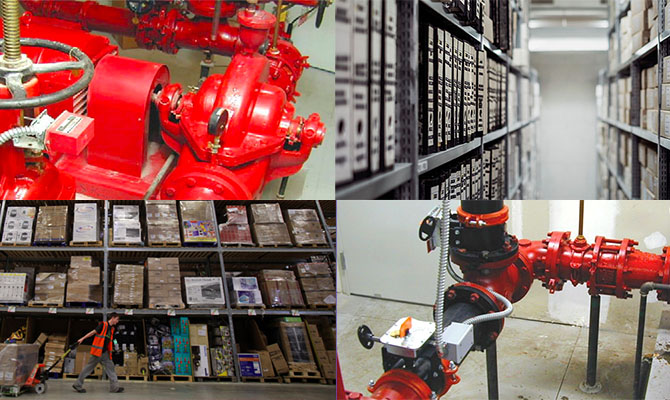Certificates will comply with CAL FIRE CEU requirements for CAL FIRE approved training courses per Title 19. Fire Smarts is a CAL FIRE approved provider for this training course which may be used towards California certified sprinkler fitter continuing education requirements that include completing 30 hours every three years to maintain the state certification (Section 946). CAL FIRE CEU’s are assigned based on 0.1 CEU per training contact hour. Learn more about CAL FIRE licenses and registration at https://osfm.fire.ca.gov/govmotus-fire
Course Description: This 10-hour course is based on the California adopted edition of NFPA 20 ‘Standard for the Installation of Stationary Fire Pumps’ and NFPA 13 ‘Standard for the Installation of Sprinkler Systems’ and covers how fire pumps operate and their requirements as well as storage fundamentals and protection requirements. This includes how to select an appropriate fire pump type and size as well as how to measure performance. Types of storage and how to determine and apply the applicable requirements will also be covered.
Course Modules:
Module 1 – Introduction to Fire Pumps – 1hr
This module focuses on the use of fire pumps with fire protection systems. Using NFPA 20 Standard for the Installation of Stationary Fire Pumps, the presentation covers the different pump types, acceptable pump drivers, and the various pump controllers. A review of the factors used to determine the need for a fire pump will be given along with an overview of the process for determining the best type of pump and driver including factors such as the severity of the hazard or risk being protected, installation costs, and performance reliability. Finally, using NFPA 25 Standard for the Inspection, Testing, and Maintenance of Water-Based Fire Protection Systems, the basic requirements for the periodic inspection, testing, and maintenance of fire pumps are discussed.
Module 2 – Fire Pump Basics and NFPA 20 Requirements – 1.5hrs
This module provides an introduction to the basic operating principles and general installation requirements of centrifugal fire pumps based on NFPA 20. Participants will learn key definitions and terminology as well as the types of acceptable fire pumps available. Sizing of pump assembly components will be covered and how flow and pressure are affected. The presentation will look at various fire pump arrangements including suction piping and discharge piping components and devices. Finally, participants will learn approved means of controlling maximum discharge pressures for centrifugal fire pumps.
Module 3 – Fire Pump Selection and Performance – 1.5hrs
This module provides an introduction to the basic centrifugal fire pump performance guidelines and requirements based on NFPA 20. The presentation will cover rated flow and pressure guidelines and requires for fire pumps. Participants will learn the effects of diesel and electric driven fire pumps on overall pump performance. A detailed review of constructing a fire pump curve and interpreting flow, pressure, efficiency and horsepower will be given. Finally, participants will learn how to use the fire sprinkler and standpipe design criteria to select a fire pump when designing a fire sprinkler system.
Module 4 – NFPA 20 Sizing of Fire Pumps – 1.5hrs
Based on NFPA 20 ‘Standard for the Installation of Stationary Pumps for Fire Protection’, this module covers the process of sizing a fire pump based on the needs of the water-based fire protection systems it will service. Participants will learn key definitions and terminology as well as the process for reviewing system demands and sizing of pump assembly components. Finally, the presentation will discuss approved means of controlling maximum discharge pressures for centrifugal fire pumps.
Module 5 – Storage Fundamentals for Fire Sprinkler Systems – 1.5hrs
This module will provide an understanding of storage arrangements and what fire sprinkler requirements are found in NFPA 13 ‘Standard for the Installation of Sprinkler Systems’ to protect these types of hazard. The presenter will discuss the history of fire sprinkler protection for storage including ‘control vs suppression’ sprinkler systems. Participants will learn storage related definitions and how they impact protection requirements including methods such as solid pile, palletized, shelf and rack storage as well as considerations for array, encapsulations, stability, container, flue spaces, clearance, shelf types and aisle widths.
Module 6 – Understanding NFPA 13 Storage Requirements for Fire Sprinkler Systems – Part 1 – 1.5hrs
This module provides an introduction to the basic operating principles and general storage requirements for fire sprinkler systems based on NFPA 13. Participants will review key decision points to apply approved design options for fire sprinkler use with storage applications. Participants will learn key definitions and terminology as well as the types of storage and the foundational questions of “What is being stored?”; “How is it stored?”; and “How high is it stored?
Module 7 – Applying NFPA 13 Storage Requirements for Fire Sprinkler Systems – Part 2 – 1.5hrs
This module provides an introduction to the basic operating principles and general storage requirements based on NFPA 13. This module is a continuation of the ‘Understanding NFPA 13 Storage Requirements for Fire Sprinkler Systems’ module. This presentation will focus on applying the knowledge gained from the previous module to assist participants in selecting protection criteria that can be applied to protect storage occupancies.
Click Here to Register Online
Format: Instant Access Recorded Webinars
CEUs: Based on 10 contact hours of training (see CEUs tab for details)


